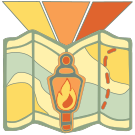Learn About Association: Difference between revisions
imported>Jacob Robertson No edit summary |
imported>Jacob Robertson |
||
| Line 27: | Line 27: | ||
== Step 2 - Learn About Nonself == | == Step 2 - Learn About Nonself == | ||
During this step, you'll experiment with | During this step, you'll experiment with the idea that there is no permanent, unchanging self. | ||
=== Lookouts === | === Lookouts === | ||
* '' | * '':'' | ||
* '' | * '':'' | ||
{{:A Crowd of People and You|Header=trail}} | {{:A Crowd of People and You|Header=trail}} | ||
Revision as of 02:12, 21 July 2023
Overview
| Trail: Learn About Association | |
| Trail: Learn About Association | |
|---|---|
| Landmarks | Observe Duality and Connectedness Observe Impermanent People Observe Emotions From Outside |
What are Trails?
A Trail in the context of Everyday Enlightenment is a curated journey of self-discovery and personal growth. It is a structured way of traveling through concepts and practices and is designed to guide you towards mindfulness and deeper understanding. Using a Trail helps you systematically navigate and explore the vast landscape of meditative insights, providing you with achievable goals and practical techniques to integrate these insights into your everyday life.
What is Association?
Where will this Trail take you?
This trail is designed to take you to a place where you have a basic understanding of the Beacon of Association, including the Lenses of Nonduality, Nonself and Decentering, as well as the Credo of Unlearn the Self. Once you've completed this trail, it is recommended you read through the content on the Association page.
Step 1 - Learn About Nonduality
During this step, you will get a chance to see Duality and then try to use the Lense of Nonduality to see things in a different way.
Lookouts
- Noticing Duality: Make a point to understand what it means to see things from the perspective of Duality.
- Look again using the Lense of Nonduality: Try to really feel at a meaningful level that Nonduality is a way to experience things.
Checkpoints
- Noticing Duality: Did you see that the drink is different from You, two separate things?
- Look again using the Lense of Nonduality: Did you sense for even a moment, that there wasn't a meaningful distinction between the drink and yourself?
Step 2 - Learn About Nonself
During this step, you'll experiment with the idea that there is no permanent, unchanging self.
Lookouts
- :
- :
Checkpoints
- Discovering Craving: Did you get a chance to really notice that there is a true craving to experience?
- Being Pulled vs Thinking: Were you able to distinguish between the Pulling and the Thoughts?
Step 3 - Learn About Decentering
In this step, X
Lookouts
- Feeling the Aversion: It's important to take time and really observe what Aversion feels like.
- Being Patient: It doesn't matter how long you're patient for, what's important is practicing, and noticing what it feels like to be patient.
Skill: a
Checkpoints
- Feeling the Aversion: Did you get a chance to observe what it's like to really want something to be over, and how your mental state changes the longer you sit with that?
- Being Patient: Were you able to feel the mental state of being patient, and resting with an aversive sensation?
Destination
Congratulations, if you've completed these three Skills, and reviewed the Checkpoints, you are one Trail further along in your practice. Now that you have a basic idea of the concept, it's recommended you read through the article about the Beacon of Association, and see if it starts to click with you. Then, look for other Trails and Skills that are in the Learning Milestone that can assist you further.
Resources
To learn more about these concepts, see the following articles.
- t
- b
- d
